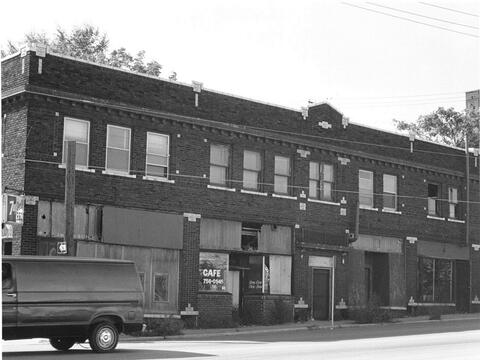October 13, 1913: The last operating cable car in Kansas City completed its final trip along 12th Street, ending thirty years of cable car dominance in the city’s public transportation. In the late 1870s, Kansas City hosted a rapidly growing population and a vibrant economy based on the cattle trade, but maneuvering through town remained a problem. Horse or mule-drawn car rides over hilly, unpaved streets entailed an unsightly and decidedly putrid experience.
This Week in Kansas City History
November 4, 1916: Walter Cronkite was born in St. Joseph, Missouri. He lived in Kansas City for the first 10 years of his life, returned to Kansas City again at the onset of his journalistic career, and then went on to become one of the most prolific television reporters in American history and the archetype for the avuncular TV news anchorman. At the age of nine, in 1925, Cronkite's first job was to peddle the Saturday issue of the Kansas City Star on the streetcar lines for a net profit of 10 cents per week. Later in life, he recounted the pleasure of lolling on the Liberty Memorial hill and observing the railroad activity at Union Station, as well as the bustling activity of a thriving downtown.
November 8, 1917: Mary Tiera Farrow and 20 other female lawyers formed the Women's Bar Association of Kansas City. Farrow was one of the few women in the United States who successfully practiced law in the early 1900s despite the discrimination that women faced in the legal field and society more generally. After having been denied the professional benefits of joining any existing bar association, Farrow led a group of 20 women in establishing their own bar in Kansas City. It was just one of many pioneering acts that Farrow undertook for herself and for women's rights more generally.
May 6, 1919: The first edition of the Kansas City Call was published. It was one of 22 newspapers published by Kansas City’s African American community near the beginning of the 20th century, but the only one that survived past 1943. From an inauspicious four page paper, the paper soon grew to one of the most successful black newspapers in the nation. The Call’s founder, Chester Arthur Franklin, was born in 1880 in Denison, Texas.
February 9, 1920: The City Council approved ambitious plans for the construction of Liberty Memorial south of Union Station. The Liberty Memorial Association, which initially consisted of 40 prominent citizens, envisioned a monument that would be among the world’s most spectacular memorials to World War I veterans. A patriotic fervor characterized Kansas City shortly after the Armistice on November 11, 1918. The war had claimed the lives of 441 Kansas Citians, and seemingly everyone wanted a memorial for their sacrifices. The City Council appointed the Liberty Memorial Association, led by lumber tycoon Robert Anderson Long, to investigate possible design, locations, and funding.
May 23, 1922: When strolling through Disneyland or Walt Disney World, few visitors would remember that Walt Disney first started his animation career in Kansas City, Missouri. Disney pursued that dream as he opened his first studio at 1127 E. 31st Street. The business, named Laugh-O-gram Films, Inc., failed dismally. Nonetheless, many enthusiasts fondly recall the story of Disney's inglorious first corporate venture in Kansas City. Born in Chicago, Illinois in 1901, Walter E. Disney moved with his family to Marceline, Missouri at the age of five.
September 17, 1922: Professional racecar drivers vied for a $30,000 prize in the inaugural race at the Kansas City Speedway. Advertisements declared that the winner would exhibit the "greatest display of skill, nerve, and daring in the history of modern sport." Although the track would soon become an obscure footnote in Kansas City's history, its design was perhaps the best in the nation when it opened to a roaring crowd of 50,000 spectators. In the "golden age" of automobile racing in the 1920s, the best tracks designed for top-end speed were made of wood.
October 6, 1922: The Kansas City Monarchs and the Kansas City Blues baseball teams embarked on a six-game series that would end with the Monarchs being crowned "The New City Champions" by the Kansas City Star. The Monarchs, founded in 1920, were an all-black baseball team in the Negro National League. The Blues, the leading minor league team of white baseball in the central United States at the time, had one of the best offenses in the American Association. By winning five of the six games, the Monarchs clearly demonstrated the talent many black players possessed in a time when white baseball players received most of the glory.
September 23, 1923: The Bennie Moten Orchestra made its first recording consisting of eight songs. By strict musical standards, the songs themselves were unrefined and not much removed from existing blues music. But the Bennie Moten Orchestra would soon build upon its earliest recordings to develop a distinct Kansas City style of jazz that later dominated the jazz scene in the late 1930s and 1940s. Bennie Moten, bandleader and namesake of the orchestra, was born on December 13, 1893.
December 25, 1925: A string of Christmas lights hung over the doorway of the Mill Creek Building at the Country Club Plaza for the first time, beginning a tradition that today is one of the most extravagant Christmas light displays in the nation. The Plaza shopping center had been conceived by Jesse Clyde "J. C." Nichols in 1912, when Brush Creek Valley was just an uninhabitable marsh with a nearby hog farm. J. C. Nichols, already a prominent real estate developer in areas south of Kansas City, believed that automobiles (as opposed to electric streetcars) would form the basis of future transportation.










